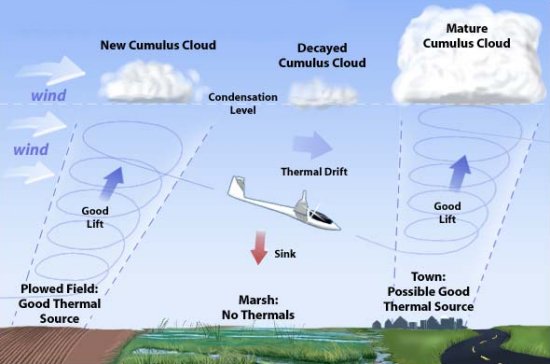
| 
| 
| 
| 
| 
| 
| 
| 
| 
|

|

|
FlyBC's Flying Tips Page


Podcasr Series from the UK
Thermalling Tips when it is windy at altitude

Thermals often are drawn like this, unfortunately thermals are only like this in calm winds.
Thermals can bend sideways in wind and you must modify your thermalling track to stay upwind longer (like a racetrack into the wind), rather than just circling in 360s.
This keeps you in the strongest core and eliminates the possibility of dropping out into the leeside sinky air caused by the backside of a thermal.
Using a GPS to check the ground speed while thermalling will help you establish the direction of the wind and helps you center in a windy thermal. Jim Reich
XC Landing Tips
You have just had the best cross-country flight of your flying career! You have flown 45 kms, and you are tired and thirsty and you have located a great LZ next to a highway.
You notice there are no trees or wind socks to tell you the wind direction, so you come into the field to land and:
A. Set up on the narrow end of the field for a long straight final.
B. Do a death-spiral over the middle of the field and hope to come out going into the wind.
C. Come over the middle of the field and use your GPS to determine the wind direction and do an "into the wind approach" and have a soft landing.
Hopefully you answered "C".
Even if you don't have a GPS you can circle over a spot in a field and determine your drift and approximate the winds for an into the wind" approach.
Jim Reich
Landing Tips
When approaching a field I see many novice pilots setting a great approach . . . but at the last minute of touchdown they crash or land on their butt.
This typically happens due to bad flare timing because of "ground rush". Watch the horizon and use your peripheral vision out the side to judge your height. If you look at the ground it will "rush up" and hit you before you can flare.
By focussing on the horizon you also have a better view of traffic and obstacles and you won't get surprised.
Jim Reich
Short Field Landing Tips
The technique used by vultures is a square spiral set up initially by arriving over the field and turning through 90 degrees, then rotated so that it has up wind, cross, downwind and base legs.
They start big and tighten the spiral as they descend adjusting the size so that the final upwind leg hits next to the spot (carcass). I've tried the same thing and it works nicely - you just lengthen the upwind leg to adjust for the windspeed, and keep the distance between turns enough so that everything is comfortable.
Cheers,
Adrian Thomas, UK
Strong Wind Landing Tips
Always overfly the landing area to the upwind side to assess the wind strength, not just what the windsock shows but the actual windspeed at altitude.
Once upwind of the landing area lose your altitude upwind always rechecking the sock over your shoulders. Do not point your back at the wind or you may get blown downwind (unless the wind strength is light).
If it is really windy, you can S-turn your way back into the field. If it is lighter as you descend, it is alright to do an aircraft approach turning base and final into the wind. Keep watching the windsock every 15 seconds or so.
Jim Reich
FlyBC Senior Instructor
Long underwear (top and bottom)
Jeans or fleece pants
2 layers of socks, inner polyester, outer wool
Wool Sweater
SupAir Flight Suit (lined)
Snow Boarding Boots or waterproof Hikers
Snow Boarding Gloves (large is better)
Balaclava or scarf to protect the neck
You can fly for hours in this stuff and be comfortable, it is just too warm to sit at launch and in the LZ for very long.
E-Mail your tips to be published here: FlyBC E-Mail
|
1253 Kilby Road, Harrison Mills, BC Canada VOM 1L0 Mobile: 604-618-5467 E-Mail: FlyBC E-Mail |
|